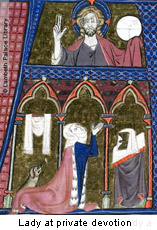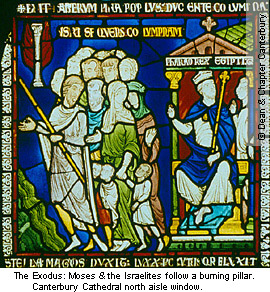
Introduction

What is pilgrimage?
| 'Pilgrimage' is a wide-ranging topic touching on many aspects of human existence, signifying not only a physical journey to a special place, but also an inner spiritual journey and indeed life itself. | Pilgrimage to holy places has deeply influenced the spiritual and physical landscapes of England and many other countries. Ancient pilgrimage destinations remain key heritage sites today. | |
| Differing interpretations of, and attitudes to, pilgrimage can cause considerable controversy and even conflict. | Why is pilgrimage important? | Pilgrimage is important in history, literature, art, architecture & social anthropology, as well as religion & spirituality. |
| Pilgrimage has fired the imaginations of writers and artists for centuries. | Pilgrimage is still very much alive. 21st century pilgrims - from all faiths and none - continue to explore the significance of place and of journey. |
Faith-based pilgrimage

Journeying to a place of special significance plays a part in almost all cultures and religions (see Place and Journey in Cultures and Faiths Worldwide). The goal may be a site given prominence by particular events, the shrine of a saint or other significant figure, or a remarkable geographical feature. Pilgrimage motivated by religious belief is still very much alive in the twenty-first century. It usually involves:
- journeying, alone or in a group
- reaching a destination
- encountering special rituals, objects and architecture
- enjoying particular experiences and benefits
- returning home
For some people pilgrimage acts as a rite of passage, for others it involves seeking spiritual or material rewards.

An image of life
'Pilgrimage' is often used to describe an individual's journey through life, sometimes as a general description of personal growth and exploration,sometimes, as in Christianity, outlining a particular spiritual focus or pathway which it is believed will lead to encounter with God.
Inner journeys
'Pilgrimage' is a term which can be used to portray an inner spiritual journey through prayer, meditation or mystical experience. In some faiths and cultures, withdrawal from the everyday world into a monastery or hermit's cell, choosing to enter into a physically-restricted life of isolation and silence, is seen as a way of setting the soul free to travel inwardly.
Football, baseball and Graceland

Pilgrimage also has meaning outside religion: it is common to speak of 'pilgrimages' to sports arenas, such as football or baseball grounds, or to the resting places of celebrities, such as Graceland, the home of Elvis Presley, or places of national significance such as the Vietnam Memorial in Washington DC. We also use the word to describe returning to places which have particular personal meaning, to celebrate, to mourn or simply to remember. An attachment to special places is a very persistent human characteristic which seems to extend across a wide range of cultures and belief systems.

Pilgrims and tourists
It is not always easy to tell the difference between pilgrims and tourists. Both may be found visiting religious sites such as great cathedrals. Both often aim to prolong the experience or transfer its benefits by recording their journeys and bringing back souvenirs (or relics). A holiday can turn into a pilgrimage - or vice versa. Although tourism proper did not emerge until the nineteenth century or become a widespread phenomenon until the middle of the twentieth century, as affluence and leisure time increased, it is clear that for centuries many pilgrimages have involved both religious and secular motives and experiences.
A kaleidoscope of meanings
As this website seeks to show, pilgrimage is not a single idea but a cluster of images which generate a variety of patterns. Together, these multiple understandings of pilgrimage have profoundly influenced patterns of living across many cultures, through many centuries, shaping art, architecture, history, literature, social interaction, spirituality and travel.
The Origins of the Terms 'Pilgrim' and 'Pilgrimage'

'Pilgrim' and 'pilgrimage' are words that have carried a range of meanings over the centuries.
The English term 'pilgrim' originally comes from the Latin word peregrinus (per, through + ager, field, country, land), which means a foreigner, a stranger, someone on a journey, or a temporary resident. It can describe a traveller making a brief journey to a particular place or someone settling for a short or long period in a foreign land. Peregrinatio was the state of being or living abroad.
Peregrinus was also used in the Vulgate version of the Bible to translate the Hebrew gur (sojourner) and the Greek parepidemos (temporary resident). These terms undergirded a central image of the Christian life. Christians were identified as temporary residents in this world whose true home was in heaven. They must therefore live and behave day by day according to the standards of their homeland as they journeyed through life. During the early centuries of the Church this was the primary understanding of the term.
As Christian pilgrimage to places considered especially holy developed in the fourth century (see The Development of Christian Holy Places), peregrinus took on a further sense within Christian thought, describing a traveller with a particular religious goal. Peregrinatio was used of the journey undertaken.
Using this Resource
This web resource can be navigated using the links in the left-hand navigation menu. The menu will expand to show all 'Pilgrimage Resources' once you enter this section.
Three forms of in-text link exist:
- Red: Glossary links - clicking these links will open a pop-up window containing a definition of the linked term or phrase. (enabling your pop-up to allow pop-ups from this site is recommended.)
- Green: Text links - these links open a pop-up window containing a literary or bible excerpt.
- Blue: Navigation links - these links enable different parts of the resource to be linked. Clicking these links will take you to a different page within the resource - don't worry if you get lost, since the 'previous page' link at the top of every page will return you to the last page you visited.
Dee Dyas



